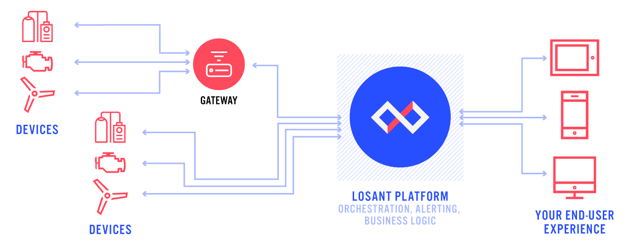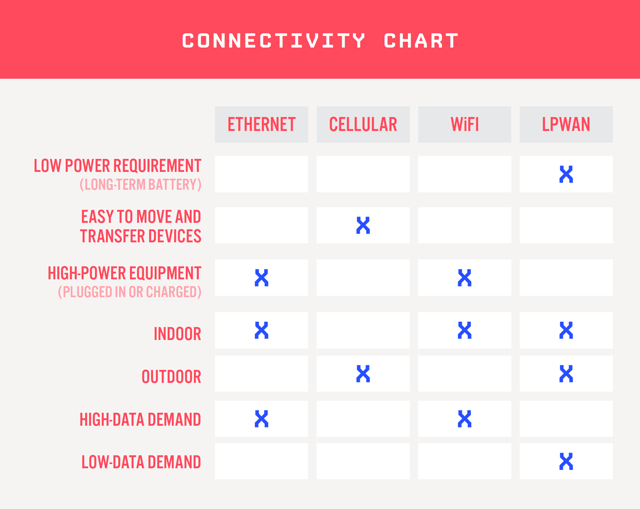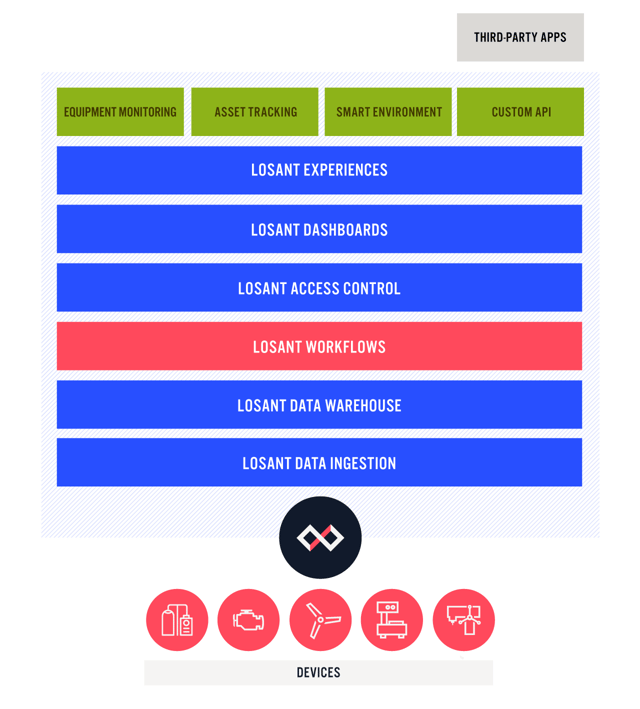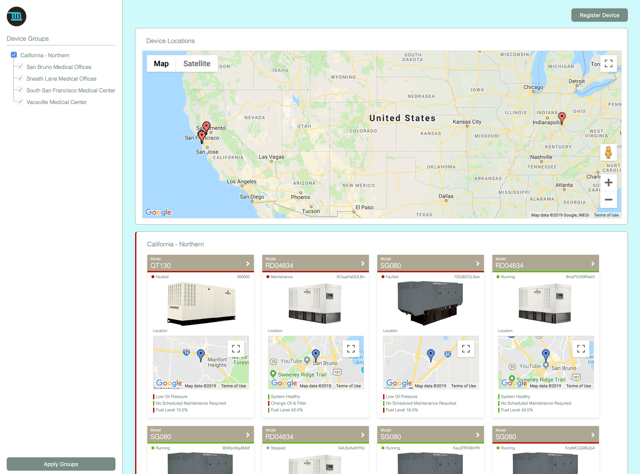The Internet of Things (IoT) involves an entire ecosystem of tools and services that must come together to deliver a complete solution. Knowing the key components of an IoT architecture and how to integrate them can be a challenge. Fortunately for you, representative architectures for specific IoT use cases have emerged over the last few years. You can look to these for inspiration when it comes to designing an IoT architecture to meet your own requirements.
The Components of an IoT Architecture
Regardless of use case, nearly every IoT solution involves the same four components: devices, connectivity, platform, and an application. Some use cases may involve additional layers, but these four components represent the foundation of every IoT solution.

IoT Devices
IoT devices make up the physical hardware component of your solution. In an Industrial Equipment Monitoring use case, these are things like engines and engine controllers. For Smart Environment use cases, these could be motion sensors or badge readers. For Asset Tracking use cases, these are GPS trackers.
In many industrial IoT and smart building use cases, customers prefer to use off-the-shelf devices that can be added to an existing environment or piece of equipment. One of the challenges when choosing off-the-shelf hardware can be gaining access to the data. Many vendors provide siloed solutions, which may work well to solve very specific problems, but don’t work well when you’d like to utilize that data as part of a broader IoT application. When investigating hardware solutions, make sure you can gain access to the data through local protocols like Modbus, Serial, or OPC UA. Some vendors may also have a cloud service where you can access the data through an API.
IoT Connectivity
In most IoT solutions, devices are sending state data to and receiving commands from a centralized IoT Platform. There are a lot of options for how that device-to-platform connection is made and it depends heavily on the environment and constraints of the device itself. If the device is outside and moving around, like in asset tracking use cases, cellular connectivity is a good choice. If the device is indoors in a home or building environment, you may have Ethernet or WiFi available. If the device is battery powered, you may need to investigate low-power options like Bluetooth Low Energy or LPWAN.
Below is a table from our guide, Business Innovation and Expansion with Industrial IoT, that can help you determine the available connectivity options based on your environment and device constraints.

IoT Gateways and Edge Compute
Some devices can’t connect directly to the central platform and require the use of an IoT gateway to bridge the gap between your local environment and your platform. This is common in industrial environments where you may be interfacing with existing equipment over local protocols like Modbus, OPC UA, or Serial. Gateways are also required when using wireless technologies like BLE and LPWAN, since those don’t provide any direct connection to your network or the Cloud.
In these situations, the device is connected to the gateway. The gateway reads the required information and then sends the data to the platform using a “backhaul” connection, like cellular or WiFi, which can access your network or the Cloud.
Gateways also allow you to introduce Edge Compute into your architecture. Edge Compute shifts processing and control from the Cloud and places it at or near your equipment. The Cloud is an important component of your architecture, but it comes with limitations outside of your control, like internet connection reliability and communication latency. If decisions need to be made in real time, or your devices generate too much data to send to the Cloud, introducing Edge Compute into your IoT architecture could be a good solution.
IoT Platform
Your IoT Platform is the central data warehouse and orchestration engine for your solution. Building a secure and scalable platform is not an easy task, so we recommend choosing a partner to provide this component of the IoT architecture for you. Choosing the right platform can be a complicated process. Below is the platform evaluation checklist that can be found in our guide, IoT Implementation: From Concept to Production.
- Industry knowledge
- IoT knowledge
- Quality and level of support available
- Limits on devices, payloads, or data
- Stability
- Functionality meets use case needs
- Security
- High availability / disaster recovery
- Continuing education
- Documentation
Architecture of an IoT Platform
IoT platforms are complicated enough that they have their own architecture requirements in order to fulfill the needs of your IoT solution. Understanding a well-designed platform can help you when choosing a partner.

The above diagram shows the architecture for the Losant Enterprise IoT Platform. This diagram shows the primary components you should look for when investigating a platform. These include Edge Compute, Data Ingestion Services, Data Warehousing, Workflows or Rules Engines, Dashboards, and End-User Experiences. The green boxes at the top represent your specific IoT applications. A well-designed platform can enable the creation of many different applications that your organization may be pursuing.
IoT Application
The IoT application delivers the end-user experience, or how you or your customers engage with the data collected from your IoT devices. This could be a mobile app, a website, a desktop application, or even a passive experience that no one interacts with directly. Building these can be challenging and time-consuming. When you’re investigating IoT platforms, look specifically for application enablement platforms, since they provide tools that can greatly accelerate that effort.
The IoT application is an important component of your IoT architecture and is where the actual value of your solution is realized. Deploying hardware and collecting sensor data is meaningless unless you’re presenting it in useful ways and solving real-world problems for your customers.

The Value of a Strong IoT Architecture
IoT solutions require a very different architecture that many companies may not be comfortable with. As companies move forward with their digital transformation strategies, understanding this architecture is important in order to be successful. Some companies, like industrial OEMs, sell millions of devices to customers distributed all over the globe. Building a reliable, secure, and scalable application with a highly-distributed system like this requires a strong foundation in order to deliver an exceptional user experience to their customers.
As you move forward with your IoT ambitions, remember these components. Each one represents a partner you’ll likely work with in order to build the complete solution. At Losant, we’ve provided the IoT platform for many customers, big and small, across a wide range of use cases. If you’re investigating platforms, we’d love to chat about your solution and see how we could help build the foundation for your IoT architecture.
